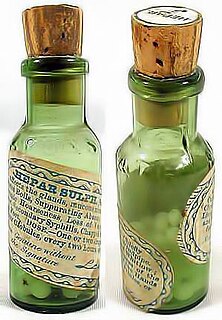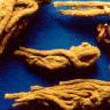Alternative medicine is any practice that aims to achieve the healing effects of medicine despite lacking biological plausibility, testability, repeatability, or evidence from clinical trials. Complementary medicine (CM), complementary and alternative medicine (CAM), integrated medicine or integrative medicine (IM), and holistic medicine are among the various attempts to capture the combination of alternative practices with those of mainstream medicine. Alternative therapies share in common that they reside outside of medical science and instead rely on pseudoscience. Traditional practices become "alternative" when used outside their original settings and without proper scientific explanation and evidence. Frequently used derogatory terms for relevant practices are new age or pseudo- medicine, with little distinction from quackery.

Homeopathy or homoeopathy is a pseudoscientific system of alternative medicine. It was conceived in 1796 by the German physician Samuel Hahnemann. Its practitioners, called homeopaths, believe that a substance that causes symptoms of a disease in healthy people can cure similar symptoms in sick people; this doctrine is called similia similibus curentur, or "like cures like". Homeopathic preparations are termed remedies and are made using homeopathic dilution. In this process, the selected substance is repeatedly diluted until the final product is chemically indistinguishable from the diluent. Often not even a single molecule of the original substance can be expected to remain in the product. Between each dilution homeopaths may hit and/or shake the product, claiming this makes the diluent remember the original substance after its removal. Practitioners claim that such preparations, upon oral intake, can treat or cure disease.

Naturopathy, or naturopathic medicine, is a form of alternative medicine. A wide array of pseudoscientific practices branded as "natural", "non-invasive", or promoting "self-healing" are employed by its practitioners, who are known as naturopaths. Difficult to generalize, these treatments range from outright quackery, like homeopathy, to widely accepted practices like psychotherapy. The ideology and methods of naturopathy are based on vitalism and folk medicine rather than evidence-based medicine, although some practitioners may use techniques supported by evidence. Naturopathic practitioners commonly recommend against following modern medical practices, including but not limited to medical testing, drugs, vaccinations, and surgery. Instead, naturopathic practice relies on unscientific notions, often leading naturopaths to diagnoses and treatments that have no factual merit.
Reiki is a Japanese form of energy healing, a type of alternative medicine. Reiki practitioners use a technique called palm healing or hands-on healing through which a "universal energy" is said to be transferred through the palms of the practitioner to the patient in order to encourage emotional or physical healing.

The National Center for Complementary and Integrative Health (NCCIH) is a United States government agency which explores complementary and alternative medicine (CAM). It was initially created as the Office of Alternative Medicine (OAM), and renamed the National Center for Complementary and Alternative Medicine (NCCAM) before receiving its current name. NCCIH is one of the 27 institutes and centers that make up the National Institutes of Health (NIH) within the United States Department of Health and Human Services.

Angelica is a genus of about 60 species of tall biennial and perennial herbs in the family Apiaceae, native to temperate and subarctic regions of the Northern Hemisphere, reaching as far north as Iceland, Lapland, and Greenland. They grow to 1–3 m tall, with large bipinnate leaves and large compound umbels of white or greenish-white flowers. Found mainly in China, its main use was for medicine. It shows variations in fruit anatomy, leaf morphology, and subterranean structures. The genes are extremely polymorphic.

The history of alternative medicine refers to the history of a group of diverse medical practices that were collectively promoted as "alternative medicine" beginning in the 1970s, to the collection of individual histories of members of that group, or to the history of western medical practices that were labeled "irregular practices" by the western medical establishment. It includes the histories of complementary medicine and of integrative medicine. "Alternative medicine" is a loosely defined and very diverse set of products, practices, and theories that are perceived by its users to have the healing effects of medicine, but do not originate from evidence gathered using the scientific method, are not part of biomedicine, or are contradicted by scientific evidence or established science. "Biomedicine" is that part of medical science that applies principles of anatomy, physics, chemistry, biology, physiology, and other natural sciences to clinical practice, using scientific methods to establish the effectiveness of that practice.
Mind–body interventions (MBI) or mind-body training (MBT) are health and fitness interventions that are intended to work on a physical and mental level such as yoga, tai chi, and Pilates.

Angelica sinensis, commonly known as dong quai or female ginseng, is a herb belonging to the family Apiaceae, indigenous to China. Angelica sinensis grows in cool high altitude mountains in East Asia. The yellowish brown root of the plant is harvested in the fall and is a well-known Chinese medicine which has been used for thousands of years.

Peucedanum ostruthium or Imperatoria ostruthium, masterwort, is a species of flowering plant in the family Apiaceae. It is native to the mountains of Central and Southern Europe, but has been widely introduced outside its native range.

Edzard Ernst is a retired British-German academic physician and researcher specializing in the study of complementary and alternative medicine. He was Professor of Complementary Medicine at the University of Exeter, allegedly the world's first such academic position in complementary and alternative medicine.
Belarus participated in the Eurovision Song Contest 2005 with the song "Love Me Tonight" written by Nikos Terzis and Nektarios Tyrakis. The song was performed by Angelica Agurbash. The Belarusian entry for the 2005 contest in Kyiv, Ukraine was selected through a national final organised by the Belarusian broadcaster National State Television and Radio Company of the Republic of Belarus (BTRC). The national final consisted of a semi-final which was a televised production and an untelevised final held on 25 December 2004 and 31 January 2005, respectively. Fifteen competing acts participated in the semi-final where the top three entries as determined by a public televote qualified to the final. In the final, "Boys and Girls" performed by Angelica Agurbash was initially selected as the winner by a jury panel, however the singer opted to withdraw her song and the replacement entry, "Love Me Tonight", was announced on 18 March 2005.

Alternative cancer treatment describes any cancer treatment or practice that is not part of the conventional standard of cancer care. These include special diets and exercises, chemicals, herbs, devices, and manual procedures. Most alternative cancer treatments do not have high-quality evidence supporting their use. Concerns have been raised about the safety of some of them. Some have even been found to be unsafe in certain settings. Despite this, many untested and disproven treatments are used around the world. Promoting or marketing such treatments is illegal in most of the developed world.

Angelica gigas, also called Korean angelica, giant angelica, purple parsnip, and dangquai, is a monocarpic biennial or short lived perennial plant from Korea and China. It inhabits forests, grasslands and banks of streams. The roots are used in traditional Chinese medicine.
Alternative veterinary medicine is the use of alternative medicine in the treatment of animals. Types alternative therapies used for veterinary treatments may include, but are not limited to, acupuncture, herbal medicine, homeopathy, ethnomedicine and chiropractic. The term includes many treatments that don't have enough evidence to support them being a standard method within many veterinary practices.

Four thieves vinegar is a concoction of vinegar infused with herbs, spices or garlic that was believed to protect users from the plague.

Angelica acutiloba is a perennial herb from the family Apiaceae or Umbelliferous. It is predominately in Japan and perhaps endemic (unique). It is now distributed widely and cultivated in Jilin, China, Korea, Taiwan and Indonesia.
Alternative medicine describes any practice which aims to achieve the healing effects of medicine, but which lacks biological plausibility and is untested or untestable. Complementary medicine (CM), complementary and alternative medicine (CAM), integrated medicine or integrative medicine (IM), and holistic medicine are among many rebrandings of the same phenomenon.












